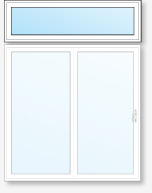 Transom windows have made a comeback in building renovations and upgrades. So what are they, and what do they cost to install?
Transom windows have made a comeback in building renovations and upgrades. So what are they, and what do they cost to install?
Transom windows historically were used to allow air and light between rooms, even when the doors were closed. They were especially common in row houses, which are typically long and narrow with windows only at the front and back.
A working or “operable” transom window is one that can be opened. Some are bottom-hinged and operate with a latch that can be opened with a pole. A side-hinged transom opens like a casement window or a door, and a top-hinged transom opens at the top.
This style of window rests on the horizontal beam above a doorframe. It’s a relatively ancient form of window, dating from medieval Europe. It was mostly used back then in public buildings or homes of the well-to-do – the average householder had very low ceilings, so a transom wouldn’t fit.
Modern homes generally have more open-plan designs that let more light and air into the interior, so transoms went out of fashion in the mid to late 20th century. However, homeowners with a flair for old-world charm are rediscovering this distinctive type of window.
Types of Transom Windows
Rectangular vs arched transom windows
The most common transom windows are rectangular in shape, but arched styles (also called fanlights) are also available. They range in height from only a few inches to a couple of feet, while the width typically spans the door plus any additional sidelights next to the door frame.
Interior vs exterior transom windows
Modern transom windows are also sometimes called transom lights. They are either installed over interior doors or front and back doors that lead to the exterior.
Interior transoms give your home a nostalgic look, while also increasing the feeling of openness between rooms. This can give your space the illusion of size – perfect for interiors with small rooms that lead into each other.
Exterior transom windows are often sold as part of an entire door system. This makes them easy to install. They’re manufactured as a sealed unit, so they offer increased weather protection.
Stock vs custom transom windows
You can purchase stock transom windows that fit standard door widths. If you have a particular style of door, you can also order custom-sized transoms. These are more expensive than stock windows.
Operable vs inoperable transom windows
Both interior and exterior transom windows are either fixed (inoperable), or able to be opened (operable).
Most indoor transoms are inoperable and purely decorative.
If you want operable exterior transom windows, you’ll have to consider issues like weather and insects. Some can close manually, but you’ll need a window pole. Some operable transoms are motorized and open or close with wall-mounted control panels.
Some high-end transoms even come with built-in moisture sensors that automatically close the window if it begins to rain!
Transom Window Installations – What Should You Know?
Before you decide to install these classic architectural details in your home, you have to consider two main factors – structure and style.
Structure
It’s vital to ensure that a transom window will suit your home structurally. Installation issues will vary depending on door and ceiling height, whether the wall is interior or exterior, and whether the wall bears weight.
High ceilings are better suited to transom windows than standard eight-foot ceilings. Narrow transoms are available, but they’ll allow much less light through. A load-bearing wall might need an entire section opened up to change the door framing and add additional structural support.
Style
Once you decide that your home structure can accommodate transom windows, you can choose your design. While simple glass transoms are popular, you can also choose from a wide range of sophisticated leaded or stained glass patterns.
Some transom windows feature muntins, which are straight or curved bars fitted between adjacent panes of glass. Diamond and square patterns are available, as are elegant Federal-style transom windows with curves and arches.
If you have an existing door, make sure your transom window incorporates some of your door’s architectural design elements.
Transom Window Prices
Transom window costs will vary depending on the material, the intricacy of design, and motorized functions.
Exterior transom windows can be fitted with cladding over a wood frame, which increases the cost but adds vital weatherproofing. If you buy a combo that includes a door, sidelights, and transom window in a single unit, you can expect to pay into the thousands.
Here are the various basic prices you can expect to pay for transom windows averaging around 32”x 12”:
- Non-operable vinyl, aluminum, or lower-grade wood windows can cost under $100.
- Better grade wood transom windows cost around $140.
- Premium wood fully-operable windows cost around $240.
Transom windows installation cost is around $75 – $200 per opening. This price can also vary extensively depending on the kind of renovations your walls will need.
Conclusion
If you’re replacing transom windows on a renovated older house, you can find window models that will suit any budget.
Transom windows are best suited to homes that require a classic, elegant touch. They add subtle extra lighting and will complement other styles of windows like double-hung or casement windows.

